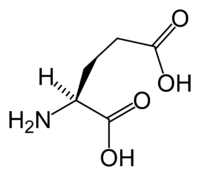
Photo from wikipedia
This study investigated differences in the concentration of gamma‐aminobutyric acid (GABA) and the combination of glutamine and glutamate (as GLX) in the early visual cortex of patients with episodic migraine… Click to show full abstract
This study investigated differences in the concentration of gamma‐aminobutyric acid (GABA) and the combination of glutamine and glutamate (as GLX) in the early visual cortex of patients with episodic migraine and the influence of transcranial direct current stimulation (tDCS) on GABA and GLX. In this single‐blind, sham‐controlled trial, we randomly assigned patients with episodic migraine to receive daily anodal tDCS or sham stimulation. In addition, we included healthy controls. We acquired proton MR spectroscopy data of the visual cortex with 3 Tesla MRI at baseline and from migraine patients directly after the stimulation period and 4 months later. In 22 migraineurs and 25 controls, the GABA and the GLX concentrations did not differ at baseline between the groups. tDCS resulted in reduced concentrations of GABA but not GLX or the migraine frequency directly after the stimulation period, but not 4 months later. The changes in the levels of GABA in the early visual cortex of patients with episodic migraine in the interictal period suggest an effect of tDCS that allowed for subsequent changes in the migraine frequency. However, we might have missed relevant variations in the concentrations of these neurotransmitters during the follow‐up period, as changes in migraine frequency appeared after the first MRI and disappeared before the second.